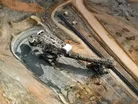5 Challenges of Integrating Automation

In times of instability, with profit margins rising and falling with fluctuating commodity prices, the idea of implementing automated processes becomes even more appealing. At its best, automation can equate to increased efficiency (which itself gives way in turn to increased productivity) and increased worker safety as more difficult or dangerous jobs are given over to machines while employees stay safely behind the controls.
There’s no doubt that automation is ramping up and gathering interest in the mining industry: according to surveys taken earlier this year, 77 percent of mining specialists consider automation a top priority while more than half believe that the mining industry should be investing more heavily in automation technology than it has been. Some mining companies are already ahead of the curve, like BHP Billiton whose CEO has stated that the effective implementation of automation technology could save the mining industry billions in cost savings and decreased time lost to work injuries.
But automation is still in relatively stages, and there are still a lot of challenges to overcome before automation in mining reaches its maximum potential:
1. Integrating Old Systems with New Systems
Automation doesn’t happen overnight — performing a complete equipment overhaul would be beyond cost prohibitive for most companies, which means that automated equipment will more often than not be plugged in one or two puzzle pieces at a time. Because of this, mining and equipment companies are going to have to work together closely to ensure that new systems are able to integrate and interoperate seamlessly with older systems.
2. New Skill Sets Needed for Workers
Skilled workers are essential to any job. But as automation becomes more widespread, the skills and training needed from workers in the mining industry will change dramatically. There will be a rise in the need for employees who are able to control and even repair automated systems; as this happens, one challenge will be finding the right employees to fit these changing roles. It will also be important for established mining outfits to offer the proper training to ensure that new workers are ready for the job at hand.
3. The Way Business Operates
Change is not only in store for new employees: as automation is implemented, roles will also change at existing mining operations and challenge executives to rethink positions and fits for their existing employees. In addition to providing training for new employees, a mining company considering automation should also make sure that its long-term employees are given the tools and training necessary to adapt to their likely changing roles.
4. A New Definition of Safety
Any time new equipment pieces, systems, and processes are brought online, there is a potential for safety risks to shift and change and for new risks to arise. As automation becomes more prevalent, a challenge that companies will be tasked with is assessing these new risks and developing new protocols and training for workplace safety to match the changing nature of the work at hand.
5. The Risks of Being a Pioneer
There’s a certain prestige to being the first to try new things. But along with the benefits, there are also costs to being a pioneer in newer fields like mining automation: if issues and challenges in your automation integration process arise that no one foresaw, those on the front lines will not have the luxury of being able to look to more experienced peers for advice, and will have to troubleshoot 100 percent internally without much support. For some, that’s an intimidating thought. But for others, it’s a welcome and exciting challenge and a chance to set new standards that will live on into the future.



